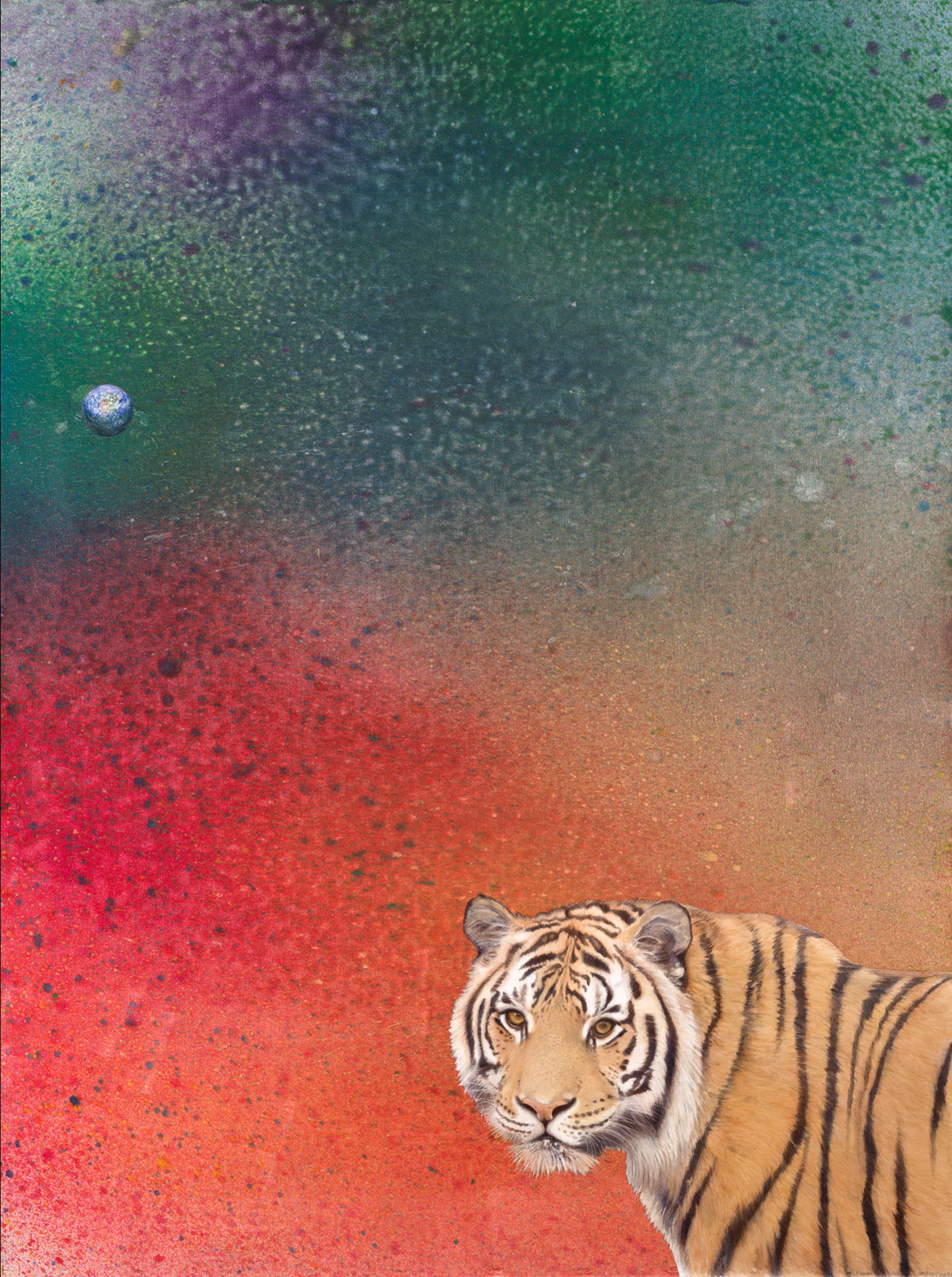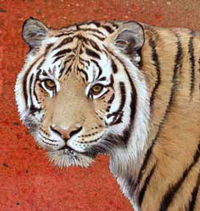An International Traveling Exhibition
by Calley O'Neill and the Rama Team, Featuring Rama, the Artist Elephant
A JOURNEY OF ART AND SOUL FOR THE EARTH
RAMA: AMBASSADOR FOR THE ENDANGERED ONES
Speaking Passionately on Behalf of Those who Cannot Speak
by Calley O’Neill and Rama the Elephant with Jeb Barsh
AMUR TIGER (PANTHERA TIGRIS ALTAICA)
STATUS: Endangered • CITES l
The Amur Tiger’s (formerly known as the Siberian Tiger) effective population size is estimated at approximately 450 mature individuals, with a declining trend, and with no sub-population containing more than 50 mature individuals. Only 20 percent of the Russian tiger population is found in protected areas and heavy poaching is driving the decline. While the population has been relatively stable for over a decade due to intensive conservation efforts, if current trends continue, tigers will become extinct in the wild in the near future.
Amur Tigers are the largest cats in the world. Well known for their power and strength, Amur tigers live solitary lives in the very harsh climate of the mountainous coniferous forests of Russian Far East, Eastern Manchurian mountain system and parts of North Korea. Fortunately, this far north the human population is lower than in any other tiger habitat; the ecosystem is complete and the forests are vast, allowing extensive natural roaming and hunting grounds.
By the 1940’s, hunting had all but annihilated the Amur Tiger population. There were only 40 tigers remaining in the wild. Russia instituted full protection for the tiger and by the 1980’s, there were about 500 individuals. After the Soviet Union collapsed, poaching increased, yet intensive international conservation efforts have kept the population stable at around 450 individuals. Conservation biologists put it simply. Wild tigers are dying. They are on the brink of extinction, despite millions of dollars spent to save one of the most iconic and beloved animals on Earth. If current trends continue, as they are expected to do, tigers will become extinct in the wild in the near future. Their habitat throughout India, Russia, China and Southeast Asia has been fragmented, degraded and deforested and large-scale illegal logging in the Russian Far East primarily exported to China for furniture and flooring continues. Illegal logging not only threatens the long-term survival of the tigers and their prey due to habitat destruction, it imperils an array of other species and the indigenous people and forest villagers who depend on the native oak, ash, elm and linden forest in the Taiga for their survival.
 | ||||
 | ||||
John Robinson, executive vice president for conservation and science at the Wildlife Conservation Society (WCS) and his illustrious colleagues in conservation biology, put forth a proposal in the journal, PLoS Biology. They propose protecting just 42 sites across Asia, covering less than 100,000 sq. km and just 6% of the tigers’ range where over 70% of the remaining wild tigers live. Protecting these 42 sites can give the wild tigers the protection they need to arrest and potentially reverse their declining numbers. Just like the biodiversity hotspots, saving this tiny area could save the tigers as well. This is the most important and efficient opportunity to conserve most of the remaining wild tigers. PLoS.
Knowing where your wood comes from when you buy flooring or furniture is exceedingly important. Buy only products or wood certified by the Forestry Stewardship Council (FSC). If FSC-certified products are not available, avoid buying any wood products from the Russian Far East.
The painting reference photography is by Michael Durham, Oregon Zoo photographer.
FARE THEE WELL BELOVED
Accompanying each painting will be a freestanding wildlife prayer wheel made by master wood turners and ceramic sculptors from around the United States. Seattle based master wood turner,
This tribute to the tiger is hand-turned by Dr. Thomas Hohl with ebony, hard white maple and Osage-orange woods
These magnificent wildlife wheels are designed to reflect unique qualities of each animal, honor their importance and move energy in their direction for their protection.
Traditionally, Tibetan prayer wheels are utilized to bring blessings and to clear negativity. Spinning prayers placed inside a Tibetan prayer wheel is said to powerfully help all of life— animals, birds, insects, fish, and humans.












